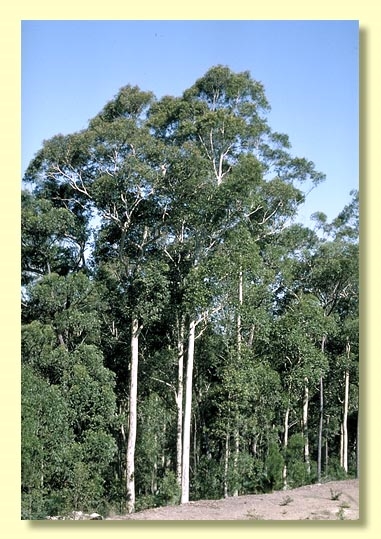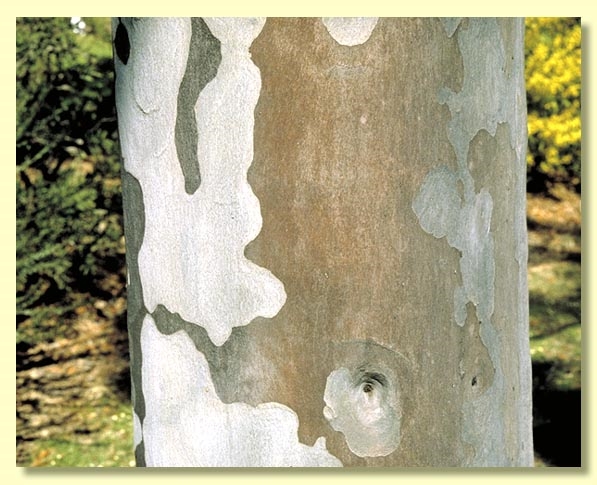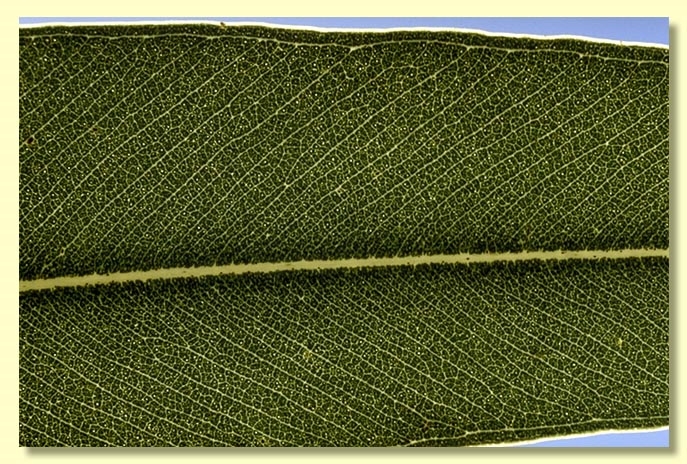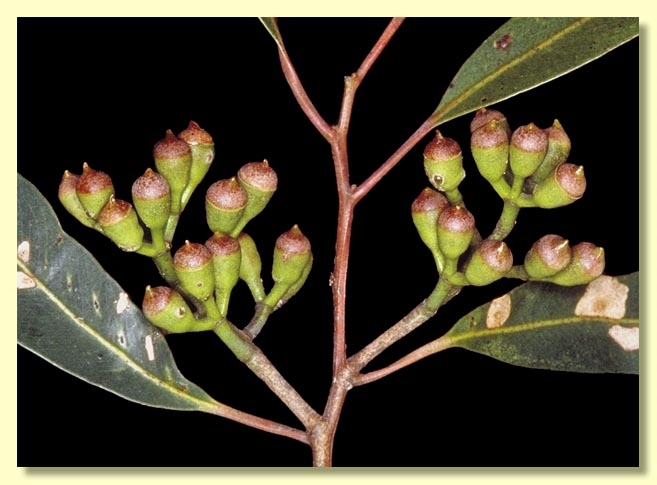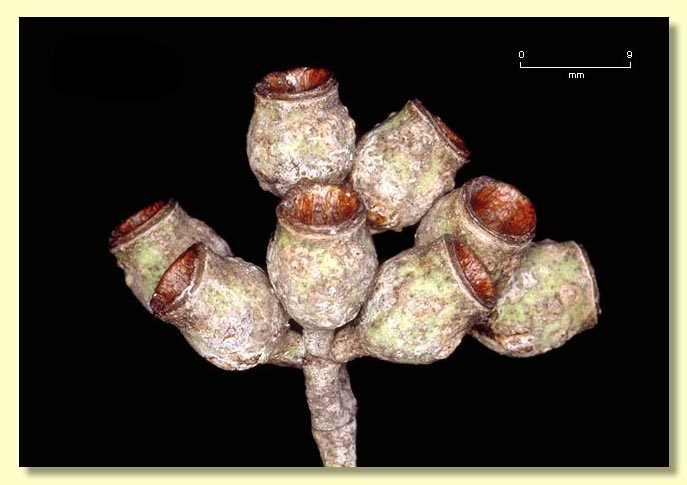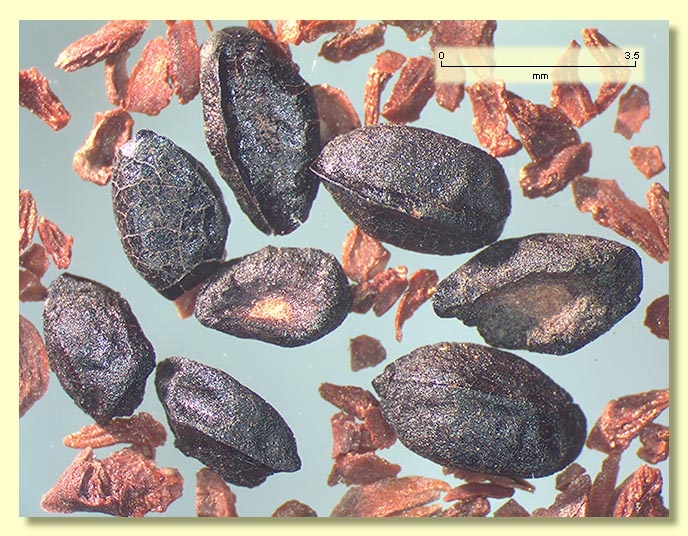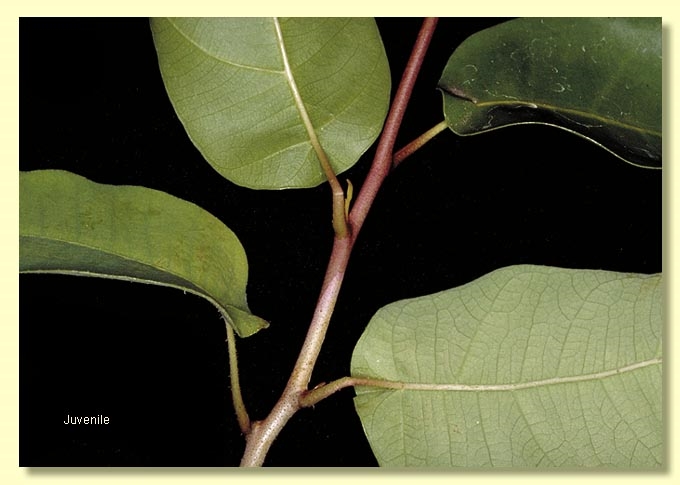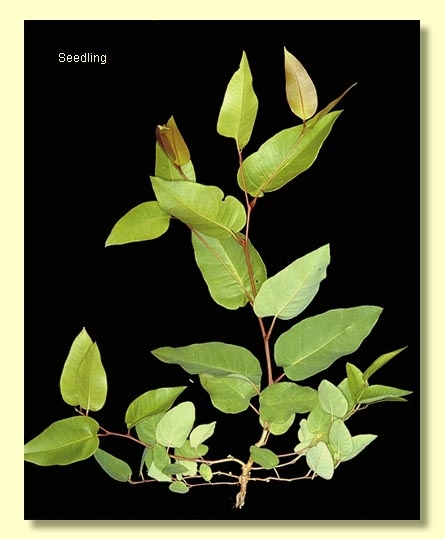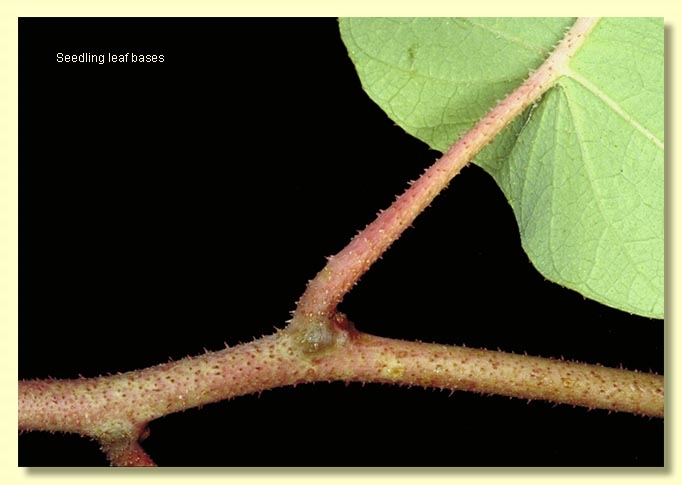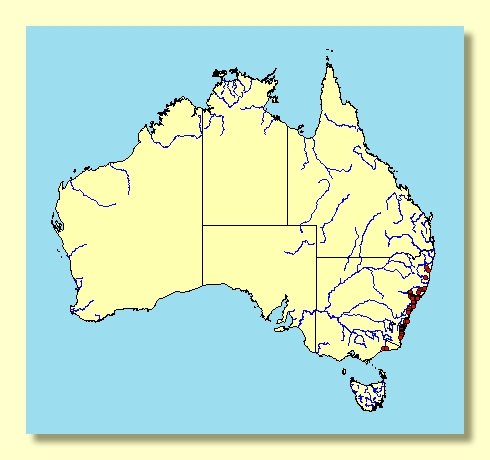Euclid - Online edition
Corymbia maculata
Corymbia | Politaria
Eucalyptus maculata Hook., Icon. Pl. 7: 619 (1844). T: Maitland, NSW, J.Backhouse 37: syn: K, NSW; New Holland, C.Fraser s.n.; syn: K; Liverpool, NSW, collector unknown; syn: MEL; Newcastle, NSW, ?L.Leichhardt s.n.; syn: MEL.
Bark smooth, mottled cream, yellow, blue-grey, pink-grey, to green-grey or brown, sometimes becoming granular with age.
Juvenile growth (coppice or field seedlings to 50 cm): stem rounded in cross-section; juvenile leaves always petiolate, opposite for 2 or 3 pairs then alternate, broadly ovate to lanceolate, 7–19 cm long, 3–7.5 cm wide, peltate at lower nodes nodes, upper leaves may have base rounded and later tapering to petiole, green; stem, petiole and leaf scabrid until node 6–8.
Adult leaves alternate, petiole 1–2.5 cm long; blade lanceolate to falcate, 8–21 cm long, 1.2–3 cm wide, base tapering to petiole, concolorous, slightly glossy or dull, green, strongly penniveined, densely to very densely reticulate, intramarginal vein parallel to and just within margin, oil glands island.
Inflorescence axillary compound, peduncles 0.3–2 cm long, buds 3 per umbel, rarely 7, pedicel 0.1–0.8(1.2) cm long. Mature buds ovoid to pyriform to obovoid, 0.8–1 cm long, 0.6–0.8 cm wide, green to creamy, usually smooth, scar present or absent (outer operculum held to or almost to flowering, operculum scar therefore obvious only at late bud development if at all), operculum rounded to conical or beaked, stamens inflexed, anthers cuboid or cuneate, versatile, dorsifixed, dehiscing by longitudinal slits (non-confluent), style long, stigma blunt or mop-like, locules 3 or 4, the placentae each with 5 vertical ovule rows (sometimes indistinct). Flowers white.
Fruit pedicellate (pedicels 0.1–0.8 cm long), urceolate or barrel-shaped, 0.9–1.4 cm long, 0.8–1.3 cm wide, disc descending, valves 3 or 4, enclosed.
Seeds reddish black, glossy, 2–6 mm long, boat-shaped, dorsal surface smooth but also cracked, not winged, hilum ventral.
Cultivated seedlings (measured at ca node 10): cotyledons reniform to orbicular; stems rounded in cross-section, scabrid; leaves always petiolate, peltate for at least 7 or 8 nodes, opposite for 3 nodes then alternate, ovate to broadly lanceolate, 5–16 cm long, 3.5–8 cm wide, base peltate after ca 2 to 3 nodes up to ca 8 to 10 nodes then becoming rounded to tapering, more or less concolorous, dull, green. Leaves scabrid on underside and petiole until ca node 8.
Flowering has been recorded in March, April, May, June, July and September.
Corymbia maculata is an important forest tree providing timber for heavy construction, pit props, housing, flooring, bent work, tool handles, preservative-treated poles, plywood and pulp. As it flowers in winter it is important for winter honey production and maintenance of healthy beehives. It is also widely grown as an ornamental in parks and gardens.
In Western Australia C. maculata has escaped from plantings and become naturalised (Hussey et al., 1997). In Victoria, Carr et al. (1992) regard this species as an environmental weed posing a serious risk to lowland grassland and associated woodlands, and dry sclerophyll forest and woodland, noting it as widespread but occurring in small populations.
A medium-sized to tall erect tree widespread along the coastal plains and hills of New South Wales, often on shales and slates, extending as far north as Taree; also one stand in far eastern Victoria in the Mottle Range north-west of Orbost. Corymbia maculata is easily recognised in the field by the erect trunks, smooth mottled bark and green crowns, buds in clusters of 3 further aggregated into branched inflorescences in the leaf axils, barrel-shaped to urceolate fruit to 1.3 cm wide, and glossy red-black small flattened keeled seed. It often occurrs in more or less pure stands frequently with an understory of Macrozamia.
C. maculata is weakly separated from the southern, non-lemon-scented form of C. citriodora which occurs north from Lismore in New South Wales to Maryborough, Chinchilla and the Carnarvon Range in Queensland. C. maculata has a slightly more mottled trunk, often has slightly broader crown leaves and juvenile growth that is scabrid and peltate for fewer nodes. C. citriodora remains scabrid and has peltate leaf-bases on comparatively taller regrowth. C. maculata differs from the more northerly C. citriodora most noticeably in the absence of lemon-scented volatile leaf oil, but the latter also has more uniform (unmottled) bark and a conspicuously narrow-leaved crown.
The third spotted gum species, C. henryi, has comparatively coarse leaves, buds and fruit, and has few juvenile leaves with peltate leaf-bases. C. henryi occurs from Whiporie, New South Wales to Helidon, Queensland. It has adult leaves 2.2–4.5 cm wide and fruit to 0.9–1.6 cm wide.
Another spotted gum species, Eucalyptus variegata, was described by Mueller in 1859. In 1879 Mueller placed this species and E. citriodora in synonymy with E. maculata. This was reiterated by Maiden (1920). Later botanists, e.g. Boland et al.(1984) and Brooker & Kleinig (1994), seem to have included plants of E. variegata in E. maculata without directly saying so, regarding E. maculata as extending to eastern and central Queenlsand as far north as Maryborough with plants north of that latitude bearing the name E. citriodora. Chippendale (1988) included E. variegata in synonymy with E. citriodora. Hill & Johnson (1995) resurrected Mueller's E. variegata, as Corymbia variegata, and restricted E. maculata (as C. maculata) to New South Wales south of Taree and eastern Victoria. McDonald & Bean (2000) agreed with this except for the rank and reduced C. variegata to C. citriodora subsp. variegata.
In EUCLID we follow Hill & Johnson's view restricting C. maculata to New South Wales and eastern Victoria but treat C. variegata as a synonym of C. citriodora (in effect a citronellal-free chemotype of that species). All spotted gum species are important and well known in forestry and horticulture and there is considerable merit in recognizing specific distinction between the three core forms C. citriodora, C. maculata and C. henryi.
Botanists who want to go further and distinguish the two chemotypes of C. citriodora and C. maculata may find the following short key useful:
1. Foliage with strong lemon scent, bark mostly not mottled: C. citriodora subsp. citriodora
1a. Foliage not lemon-scented, bark mottled
2. Seedling/juvenile leaves still with peltate leaf-bases at node 10: C. citriodora subsp. variegata
2a. Seedling/juvenile leaves mostly lacking peltate leaf- bases by node 9: C. maculata
MORE ABOUT CORYMBIA
MORE ABOUT SPOTTED GUMS

